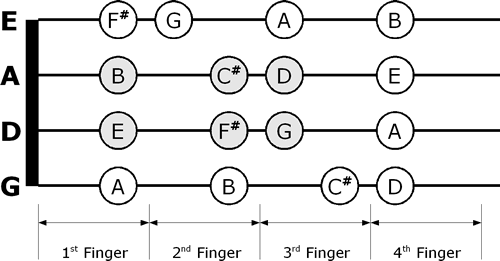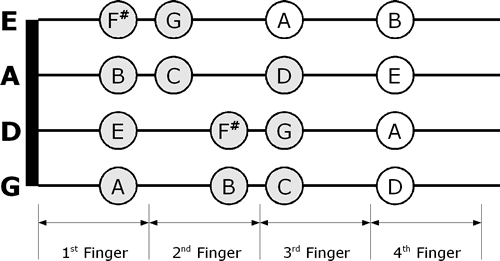Welcome to our forum. A Message To Our New and Prospective Members . Check out our Forum Rules. Lets keep this forum an enjoyable place to visit.
Currently working on errors from the latest (SimplePress) forum update. Many issues have been resoled and others are being worked on. Thank you for your patience.
 Topic RSS
Topic RSS



 (3 votes)
(3 votes) Member
 Offline
OfflineGreetings! I had a look at previous topics, but sadly, couldn't find an answer for my question, so I'm sorry if this is a repost. The violin is the third instrument I'm learning to play. Due to my previous experience with the classical guitar, my fretting (left) hand is well developed and made my transition to the violin a lot easier. The issue I'm having is playing a perfect fourth interval either up or down , e.g. THIS sheet begins with an E, which is then followed by an A. I thought that playing the E on the G string might be a workaround, but couldn't be sure enough, as it is a long distance between A and E, and I don't think it optimal to perform in this fashion. In videos, where violinists play the respective reel, I don't see them reaching that high on the neck. Am I meant to apply pressure on both strings with my index finger? Should I change finger positioning? Or is there some trick to it? Any advice would be greatly appreciated!
Regards
Honorary tenured advisor
Regulars
 Offline
OfflineMember
 Offline
OfflineThank you for the quick feedback! I seem to have missed a detail - I'm attempting to play these notes on the G and D strings. Regarding the sheet, I did post a link, but will post it again, just to be sure - SHEET
Again, thanks for the aid.
Honorary tenured advisor
Regulars
 Offline
OfflineOK. The vast majority of reels, jigs, hornpipes and the like are in either the the key of G or D, because those are very convenient keys for fast fiddle playing using open strings. Most all of them are played by the fiddle in first position only, with frequent and intentional use of open strings. One would not play these types of songs in anything other than first position if one wants it to 1. sound authentic, 2. play the tune very fast as these songs usually are (particularly reels).
Look at the first measure of the 2nd part (A-E-A-C-A-E-A). This would be played on on the D and the A strings. One would never ever see a session player play any of those notes on the G string. If you want to learn celtic music, old time music or blue grass, learn to love the 1st position and stay there -- forever.
Here it is, notice how it's played.
And this one -- just because she makes such cute faces when she plays:
A positive attitude may not solve all your problems, but it will annoy enough people to make it worth the effort. ~Herm Albright
Regulars
 Offline
Offline

Uzi said
If you want to learn celtic music, old time music or blue grass, learn to love the 1st position and stay there -- forever.
LOL! This is the only music I play and I have no need to move positions. I feel like I need to learn other positions but the music just doesn't want me too. ![]()
EDIT: The little girl's rolls are so nice!
Member
 Offline
OfflineI've been watching these videos for a while now, both, but never actually figured out the way they performed the reel. So you're advising me to play that sheet an octave higher e.g. on the D and A strings? As for the celtic/scottish/scandinavian music, I do have an immense affinity towards it. This fascination is what dragged me to invest in a violin and what gives me the mindset and dedication to learn. And what you stated as base rules for authentic fiddle playing, that's exactly what I'm striving to achieve, the ways of the folklore musicians, in other words - to play with your soul, so I'm open to tips 'n tricks for playing the fiddle, and I stress on fiddle, as for me, both instruments are next to identical, structuraly, though, what makes them different is the manner in which one interprets the music he plays, and the genre of the music itself. Sorry if I'm talking too much jibberish :P. My first instrument is the guitar, second the tinwhistle and now the violin and and am just getting into recording, a bit of a struggle at first, and can't wait to include the fiddle in a recording ![]()







Hahhaha @Uzi, awesome. Clap, clap, clap.
Opportunity is often missed because it wears suspenders and looks like hard work.
Honorary tenured advisor
Regulars
 Offline
OfflineYew said
I've been watching these videos for a while now, both, but never actually figured out the way they performed the reel. So you're advising me to play that sheet an octave higher e.g. on the D and A strings? As for the celtic/scottish/scandinavian music, I do have an immense affinity towards it. This fascination is what dragged me to invest in a violin and what gives me the mindset and dedication to learn. And what you stated as base rules for authentic fiddle playing, that's exactly what I'm striving to achieve, the ways of the folklore musicians, in other words - to play with your soul, so I'm open to tips 'n tricks for playing the fiddle, and I stress on fiddle, as for me, both instruments are next to identical, structuraly, though, what makes them different is the manner in which one interprets the music he plays, and the genre of the music itself. Sorry if I'm talking too much jibberish :P. My first instrument is the guitar, second the tinwhistle and now the violin and and am just getting into recording, a bit of a struggle at first, and can't wait to include the fiddle in a recording
The fiddle (double reed instruments aside) is among the most difficult instruments to learn, initially, and will take some time to gain the proficiency required to make pleasing sounds. As in turkey hunting, the fiddle requires the 3 P's to have a successful outcome: Practice, Patience and Perseverance. For Celtic music the first thing to learn is the G scale and the D scale in first position. These are all the notes you'll need for 90% of all the music you'll see on The Session. Practice them until you have perfect intonation for all of these notes, because they are the ones you need for most of these songs.
A positive attitude may not solve all your problems, but it will annoy enough people to make it worth the effort. ~Herm Albright
Member
 Offline
OfflineI see. Thank you, @Uzi, for the scales and info. Still, how would you suggest playing an E note, after which playing a quarter down to A? Am I supposed to apply pressure on 2 strings with a single finger or rather use two adjacent fingers and seperately press each string?
The latter, I'd guess, is contrary to the chart, but for all I know, it might be an exception. Both methods seem strange to me, though, as you said, this is a hard instrument and seemingly, not completely intuitive, so in fear of developing the wrong habit, I can't decide for myself, hence my ridicule of a quesiton.
Regulars
 Offline
Offline

@Yew conservation!!!
Check out this: http://www.celticscores.com/sh.....owtail_Jig . To increase speed, you can hold down the B and E with your index finger while adding and lifting the finger to play Gs and not play G when needed.
There are also times that you can hold down your index finger and play a group of notes - it helps you keep your place.
Violinist start date - May 2013
Fiddler start date - May 2014
FIDDLE- Gift from a dear friend. A 1930-40 german copy, of a french copy of a Stradivarius. BOW - $50 carbon fiber. Strings - Dominants with E Pirastro Gold string.
Member
 Offline
OfflineIt's all clear now! You've all been of great help, really patient and understanding. I'm sorry for mistaking fourths with fifths, hence leading to a great deal of confusion. Got the needed information, plus lots of helpful tips that'll do me well in developing. @Schaiek , I'll definetely be spending some time on that site, it looks pretty resourceful. @Fiddlerman I'll be practicing that, really in the need of some clever excercises like the ones you and @Schaiek described, other than playing tunes repeatedly, which is mostly what I've been doing. Thank you guys again : )
1 Guest(s)


 Log In
Log In Register
Register






















